Optimized Synchronous Pulse Width Modulation Strategy Based on Discontinuous Carriers
Abstract
:1. Introduction
2. Conventional Synchronous Pulse Width Modulation Strategy
2.1. Basic Principle of Synchronous Space Vector Modulation
2.2. Space Vector Implementation and Carrier Wave Implementation Equivalence Principle
3. Optimized Discontinuous Carrier Pulse Width Modulation
3.1. ODCPWM Strategy Design Principle
- The carrier wave is a peak or valley at the right edge (π/2) of the carrier design zone to satisfy the design requirement of carrier discontinuity.
- The carrier is a peak or valley at the left edge (π/3) of the carrier design zone to satisfy the design requirement of carrier discontinuity.
- To prevent the power devices of the two-phase bridge arms from activating simultaneously, which is against the inverter’s operating principle, the corresponding clamping mode of the modulating wave should also be considered while constructing the discontinuous carrier.
- The ODCPWM-I is designed according to the above principles and is the same as conventional synchronous carrier modulation. In the ODCPWM-I, each carrier has the same width in any fundamental wave period. According to principles 1 and 2, the carriers wave in region II and region I are oddly symmetric, and the carriers jump at π/3.
- Different modulation strategies can be obtained with different N and clamping methods according to the design principles. Some of the designs are summarized in Table 2. Table 2 shows that the possible carrier wave ratios chosen for the ODCPWM-I strategy are 5 and 7, defined as ODCPWM-I_5-I, ODCPWM-I_5-II, and ODCPWM-I_7. Take the ODCPWM-I_5-II strategy shown in Table 2 as an example. As shown in Figure 5, the A-phase voltage modulation wave in a fundamental wave period is compared with the carrier wave. The modulation wave in the II region is clamped to a higher level to ensure that design principle 3 is satisfied.
- Unlike the above strategy, while satisfying the above design principles, ODCPWM-II has different carrier widths in each fundamental wave period. The angle occupied by the half-triangular carrier in the angular range of θ1 is one-half of the angle occupied by the half-triangular carrier in the angular range of θ2 in the specified carrier design zone. At this time, the carrier with a larger angle near the π/2 position and the triangular carrier with a smaller angle near the π/3 position exists in region II.
- Following the above principles for ODCPWM-II, various optimized discontinuous pulse width modulation strategies that satisfy the design principles can be obtained, and some of the designs are summarized in Table 3. The carrier wave ratios that may be selected for the ODCPWM-II are 7 and 13, defined as ODCPWM-II_7 and ODCPWM-II_13-I/II/III/IV, respectively, taking ODCPWM-II_13-III shown in Table 3 as an example. The modulating waveform is compared with the carrier waveform, as shown in Figure 6. Each π/6 is clamped in regions I and III to ensure that design principle 3 is satisfied.
- Similar to the above ODCPWM-II, the carrier width differs in each fundamental wave period in ODCPWM-III. In this strategy, the angle occupied by the half-triangular carrier in the angular range of θ1 is twice the angle occupied by the half-triangular carrier in the angular range of θ2. At this time, there exists a half-triangular carrier with a smaller angle near the π/2 position and a half-triangular carrier with a larger angle near the π/3 position in region II.
- According to the above principle for ODCPWM-III design, the possible carrier wave ratios of the ODCPWM-III are 7 and 13 according to different clamping methods. They are defined as ODCPWM-III_7 and ODCPWM-III_13-I/II/III/IV, respectively, which are uniformly summarized in Table 4, taking the ODCPWM-III_7 shown in Table 4 as an example. The comparison of the A-phase voltage-modulated waveform and carrier waveform is shown in Figure 7. Each π/6 in regions I and III is clamped to ensure that design principle 3 is satisfied.
3.2. ODCPWM Modulation Strategy Performance
3.2.1. Performance Evaluation Index
3.2.2. Optimal ODCPWM Strategy Selection
4. Experimental Verification
5. Conclusions
Author Contributions
Funding
Data Availability Statement
Conflicts of Interest
References
- Renz, E.C.; Turso, J. Toward the Application of Pulse Width Modulated (PWM) Inverter Drive-Based Electric Propulsion to Ice Capable Ships. Energies 2022, 15, 8217. [Google Scholar] [CrossRef]
- Xiao, L.; Li, J.; Xiong, Y.; Chen, J.; Gao, H. Strategy and Implementation of Harmonic-Reduced Synchronized SVPWM for High-Power Traction Machine Drives. IEEE Trans. Power Electron. 2020, 35, 5472–5481. [Google Scholar] [CrossRef]
- Jammala, V.; Yellasiri, S.; Panda, A.K. Development of a New Hybrid Multilevel Inverter Using Modified Carrier SPWM Switching Strategy. IEEE Trans. Power Electron. 2018, 33, 8192–8197. [Google Scholar] [CrossRef]
- Vasantharaj, S.; Indragandhi, V.; Bharathidasan, M.; Aljafari, B. Power Quality Analysis of a Hybrid Microgrid-Based SVM Inverter-Fed Induction Motor Drive with Modulation Index Diversification. Energies 2022, 15, 7916. [Google Scholar] [CrossRef]
- Almazán-Covarrubias, J.H.; Peraza-Vázquez, H.; Peña-Delgado, A.F.; García-Vite, P.M. An Improved Dingo Optimization Algorithm Applied to SHE-PWM Modulation Strategy. Appl. Sci. 2022, 12, 992. [Google Scholar] [CrossRef]
- Birda, A.; Reuss, J.; Hackl, C.M. Synchronous Optimal Pulse Width Modulation for Synchronous Machines with Highly Operating Point Dependent Magnetic Anisotropy. IEEE Trans. Ind. Electron. 2021, 68, 3760–3769. [Google Scholar] [CrossRef]
- Li, K.; Yuan, Q.; Nai, W. Model Prediction and Pulse Optimal Modulation of Electrically Excited Synchronous Motor at Low Switching Frequency. Electronics 2022, 11, 1173. [Google Scholar] [CrossRef]
- Busacca, A.; Di Tommaso, A.O.; Miceli, R.; Nevoloso, C.; Schettino, G.; Scaglione, G.; Viola, F.; Colak, I. Switching Frequency Effects on the Efficiency and Harmonic Distortion in a Three-Phase Five-Level CHBMI Prototype with Multicarrier PWM Schemes: Experimental Analysis. Energies 2022, 15, 586. [Google Scholar] [CrossRef]
- Janabi, A.; Wang, B. Hybrid SVPWM Scheme to Minimize the Common-Mode Voltage Frequency and Amplitude in Voltage Source Inverter Drives. IEEE Trans. Power Electron. 2019, 34, 1595–1610. [Google Scholar] [CrossRef]
- Riedemann, J.; Zhu, Z.; Stone, D.; Foster, M.; Greenough, J.; Takemoto, K.; Ivanovic, D.; Bateman, B. A Space Vector Modulation Strategy for PMSMs Operating at Low Switching-to-Fundamental Frequency Ratio. IEEE Trans. Ind. Electron. 2022, 99, 1–10. [Google Scholar]
- Gao, Z.; Ge, Q.; Li, Y.; Zhao, L.; Zhang, B.; Wang, K. Hybrid Improved Carrier-Based PWM Strategy for Three-Level Neutral-Point-Clamped Inverter with Wide Frequency Range. IEEE Trans. Power Electron. 2021, 36, 8517–8538. [Google Scholar] [CrossRef]
- Xu, J.; Soeiro, T.B.; Wu, Y.; Gao, F.; Wang, Y.; Tang, H.; Bauer, P. A Carrier-Based Two-Phase-Clamped DPWM Strategy With Zero-Sequence Voltage Injection for Three-Phase Quasi-Two-Stage Buck-Type Rectifiers. IEEE Trans. Power Electron. 2022, 37, 5196–5211. [Google Scholar] [CrossRef]
- Beig, A.R.; Kanukollu, S.; Al Hosani, K.; Dekka, A. Space-vector-based synchronized three-level discontinuous PWM for medium-voltage high-power VSI. IEEE Trans. Power Electron. 2014, 61, 3891–3901. [Google Scholar] [CrossRef]
- Fernandez-Gomez, M.; Sanchez, A.; de Castro, A.; Lopez-Lopez, J.; Zumel, P.; Fernandez, C. Design and Implementation of Two Hybrid High Frequency DPWMs Using Delay Blocks on FPGAs. IEEE Trans. Power Electron. 2021, 36, 14567–14578. [Google Scholar] [CrossRef]
- Tcai, A.; Alsofyani, I.M.; Seo, I.-Y.; Lee, K.-B. DC-link Ripple Reduction in a DPWM-Based Two-Level VSI. Energies 2018, 11, 3008. [Google Scholar] [CrossRef] [Green Version]
- Zhang, Z.; Li, B.; Zhang, G.; Wang, G.; Huang, Z.; Hu, B.; Long, T.; Xu, D. Optimized Carrier-Based DPWM Strategy Adopting Self-Adjusted Redundant Clamping Modes for Vienna Rectifiers With Unbalanced DC Links. IEEE Trans. Power Electron. 2023, 38, 1622–1634. [Google Scholar] [CrossRef]
- Lawan, M.G.; Camara, M.B.; Sabr, A.S.; Dakyo, B.; Al Ameri, A. Power Control Strategy for Hybrid System Using Three-Level Converters for an Insulated Micro-Grid System Application. Processes 2022, 10, 2539. [Google Scholar] [CrossRef]
- Lee, H.-J.; Yoo, A.; Hong, C.; Lee, J. A carrier-based adjustable discontinuous PWM for three-phase voltage source inverter. In Proceedings of the 2015 IEEE Energy Conversion Congress and Exposition (ECCE), Montreal, QC, Canada, 20–24 September 2015; pp. 2870–2875. [Google Scholar]
- Kohlhepp, B.; Duerbaum, T. Novel DPWM Modulation Scheme for Three-Phase ZVS Inverters. In Proceedings of the 2021 56th International Universities Power Engineering Conference (UPEC), Middlesbrough, UK, 31 August–3 September 2021; pp. 1–6. [Google Scholar]
- El Gadari, A.; El Ouardi, H.; Ounejjar, Y.; Al-Haddad, K. Novel Three-Phase Nine-Level Inverter and Its Control Strategies. Electronics 2022, 11, 3348. [Google Scholar] [CrossRef]


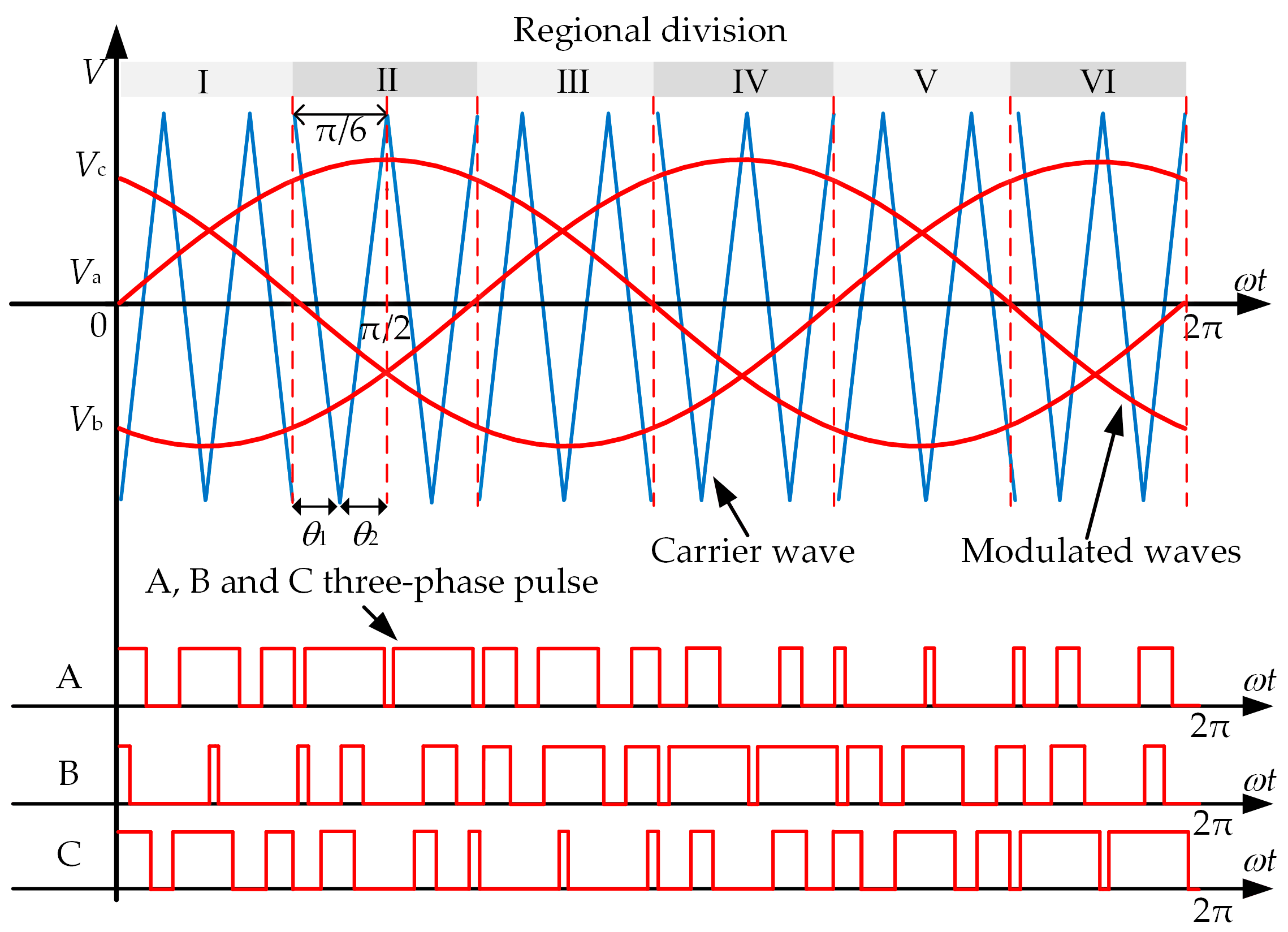
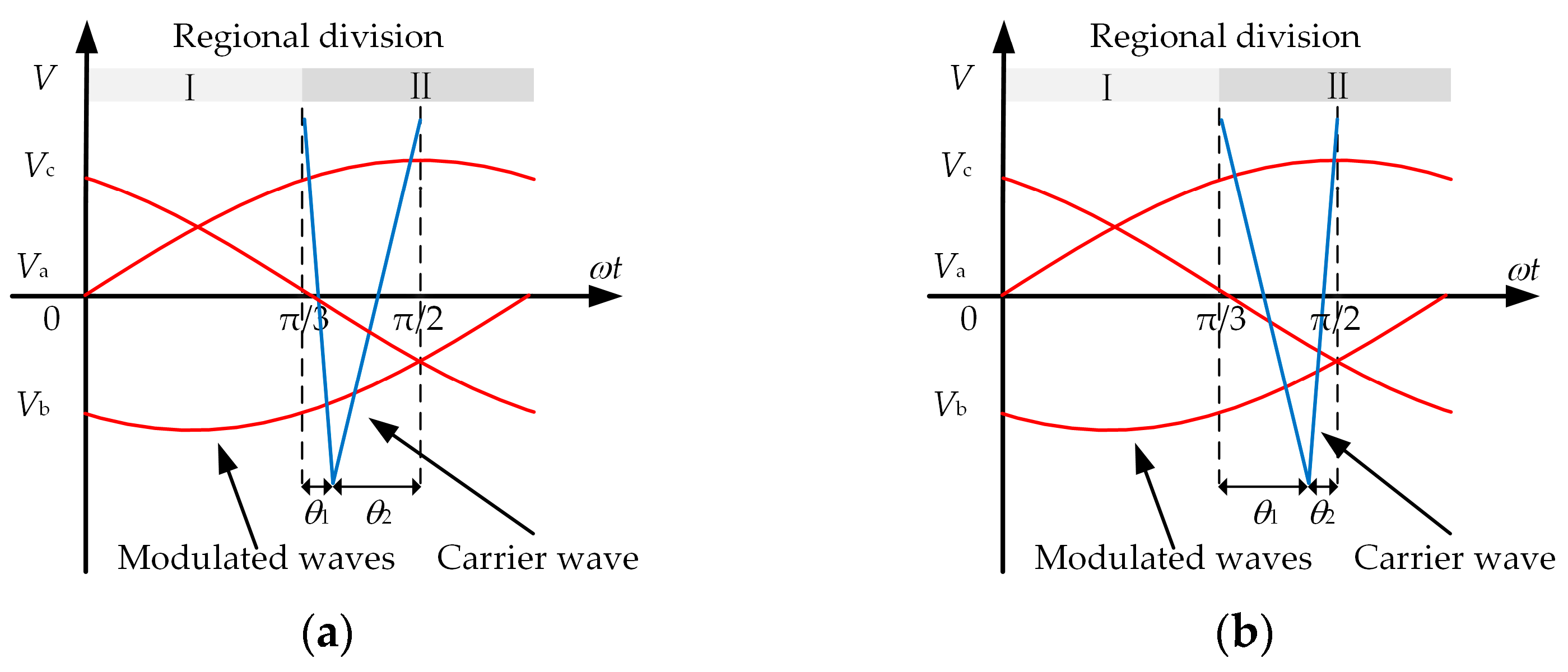
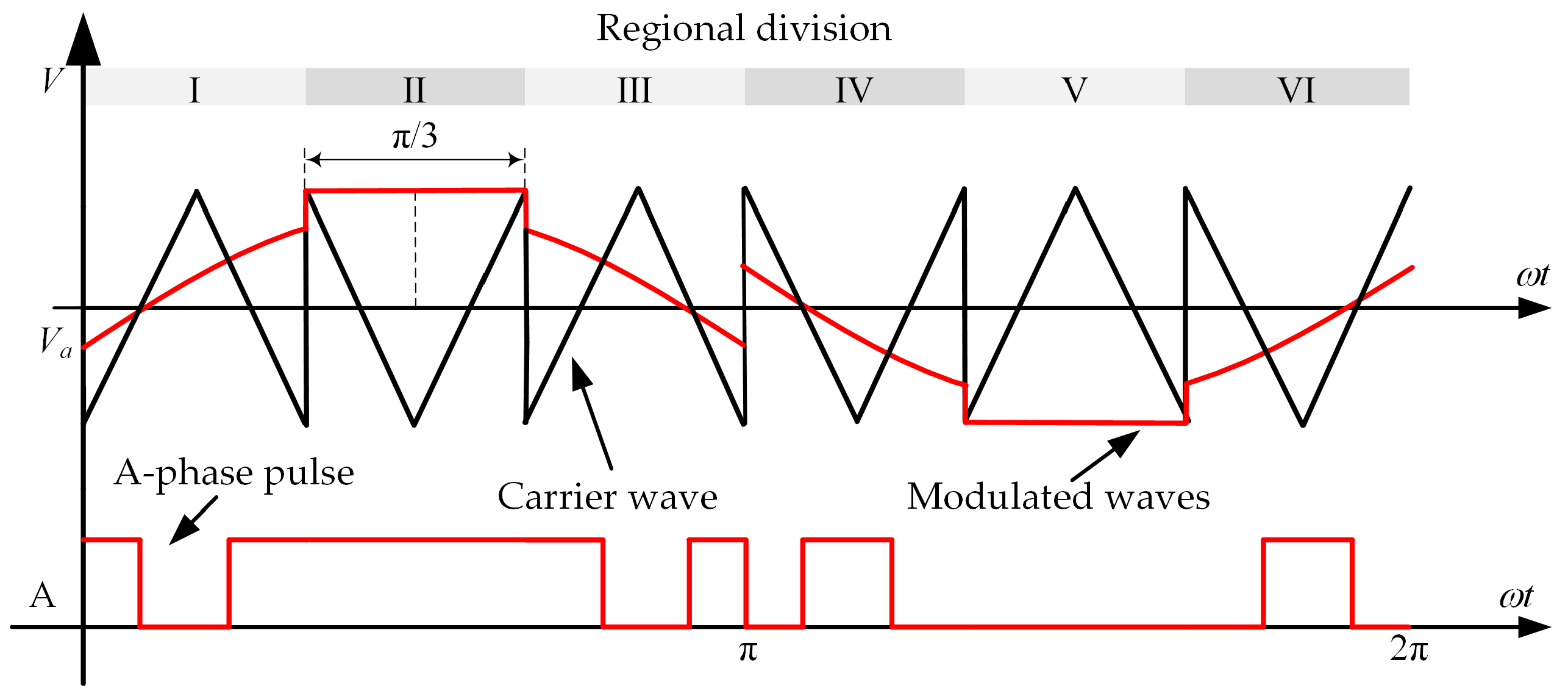


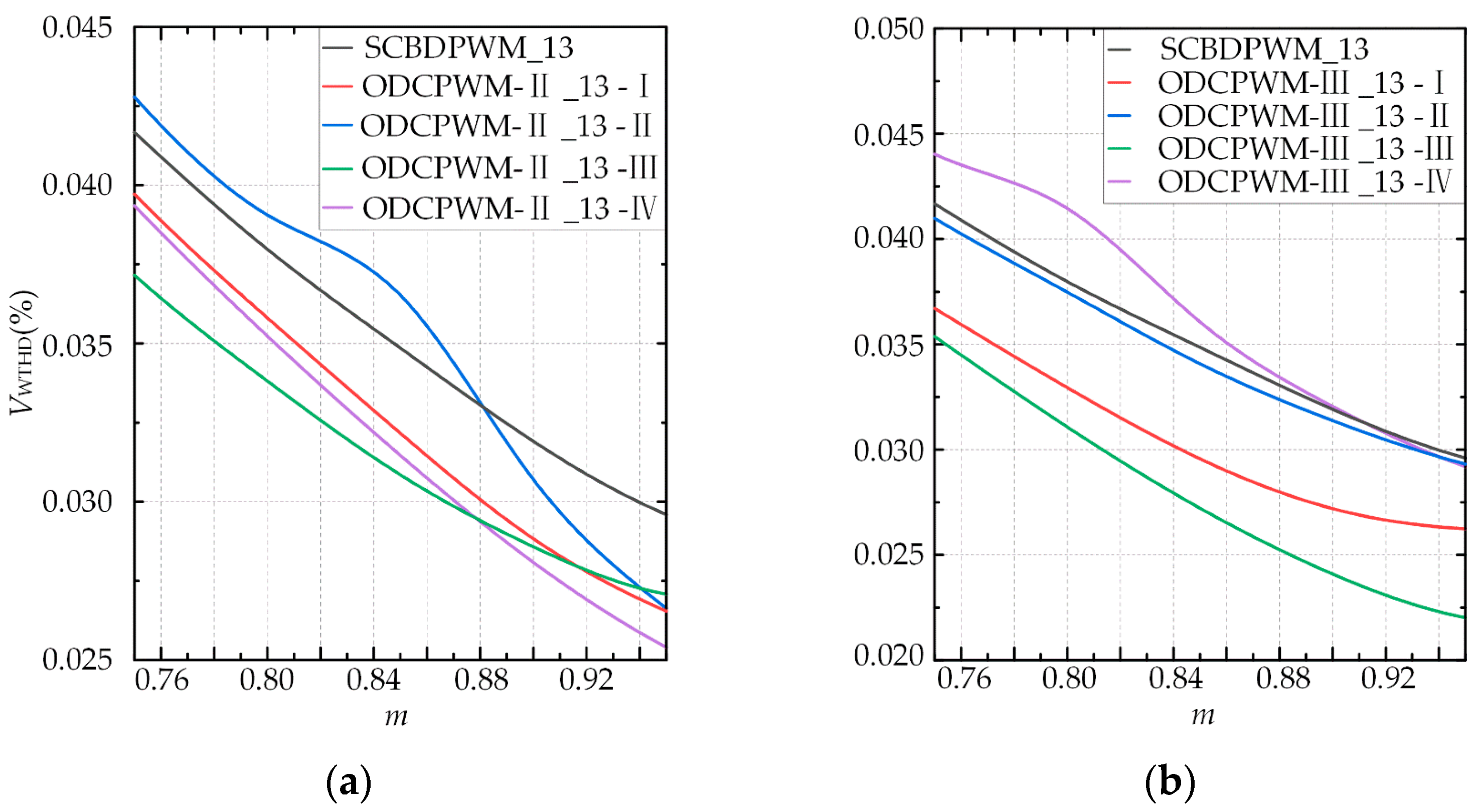

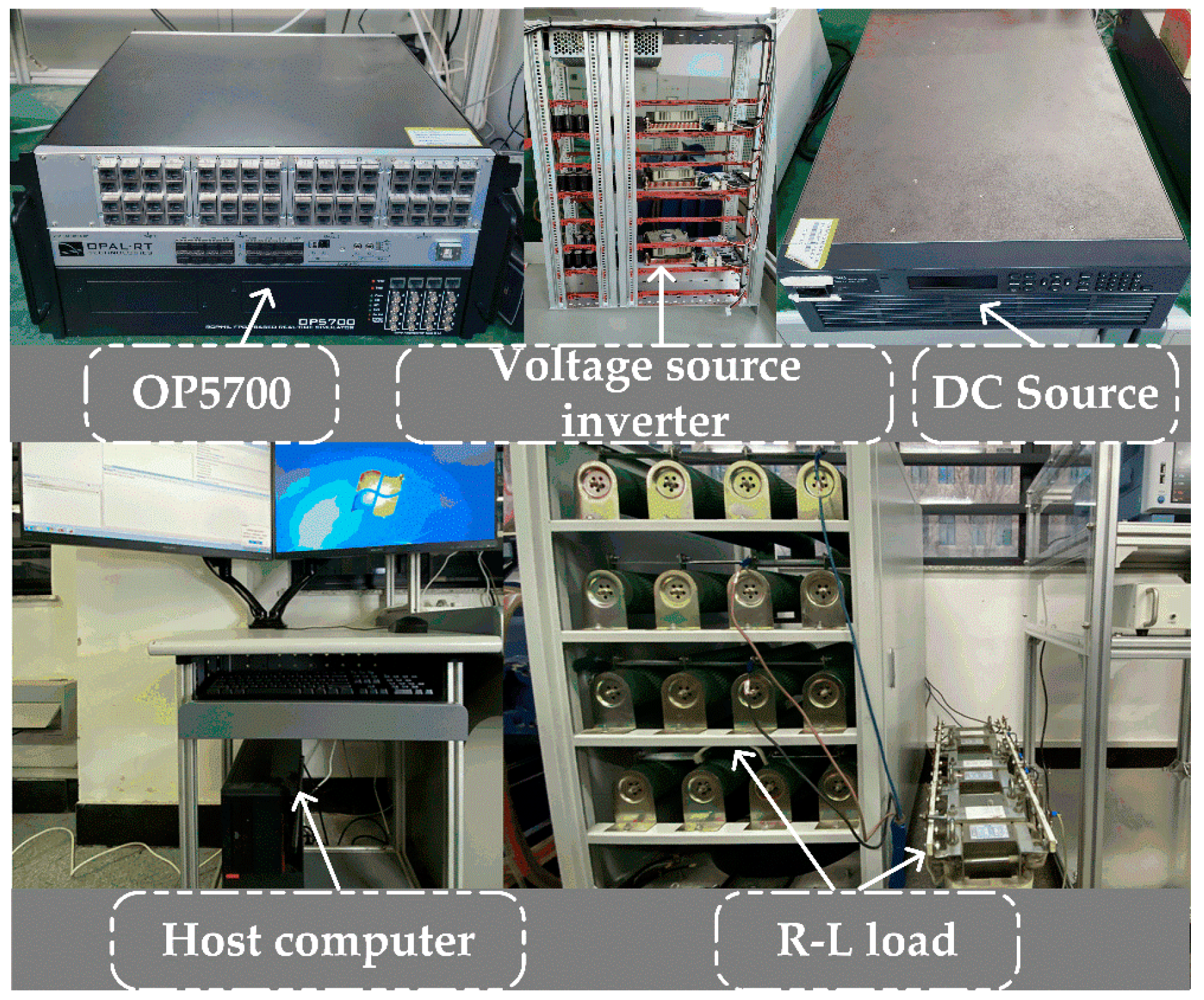

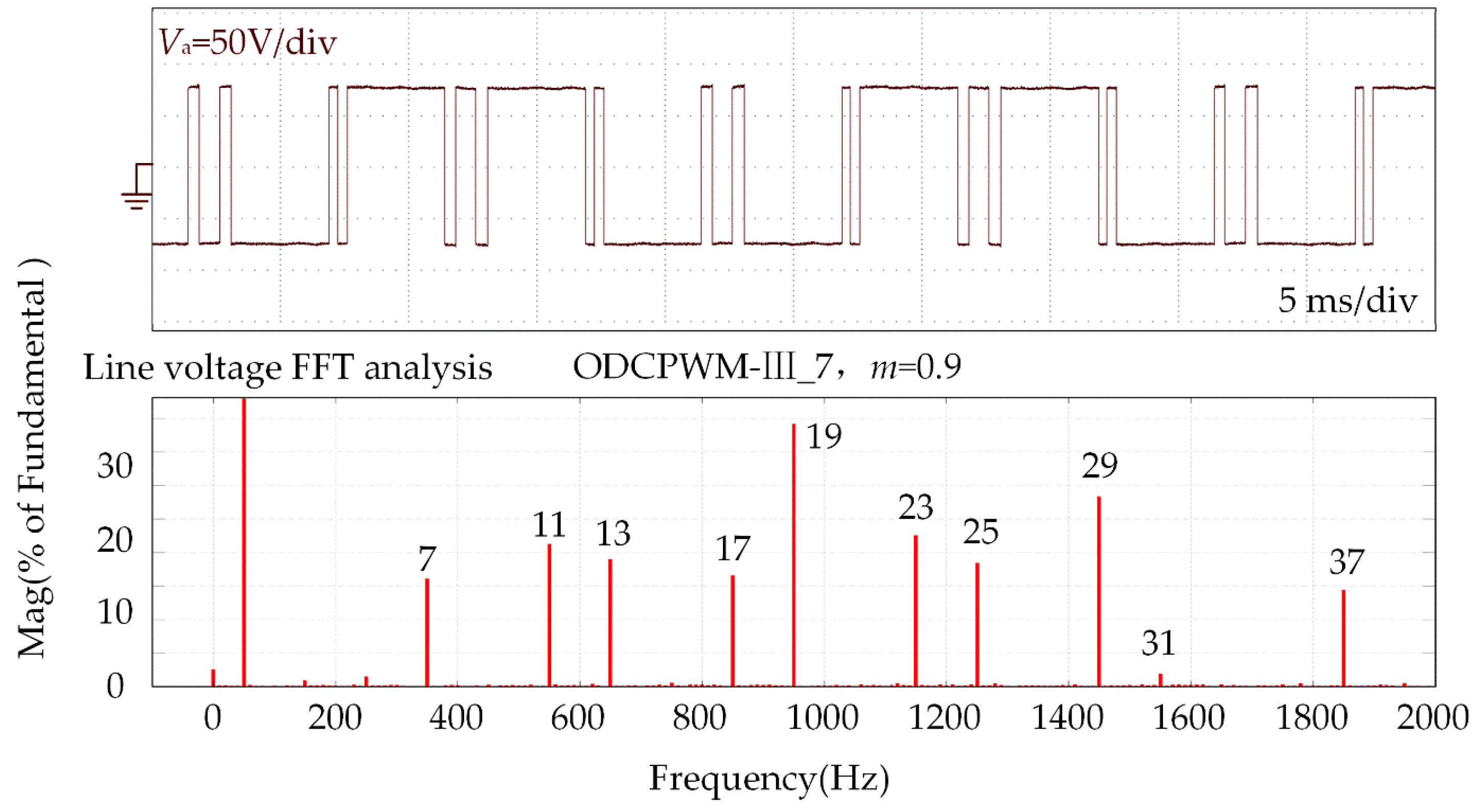


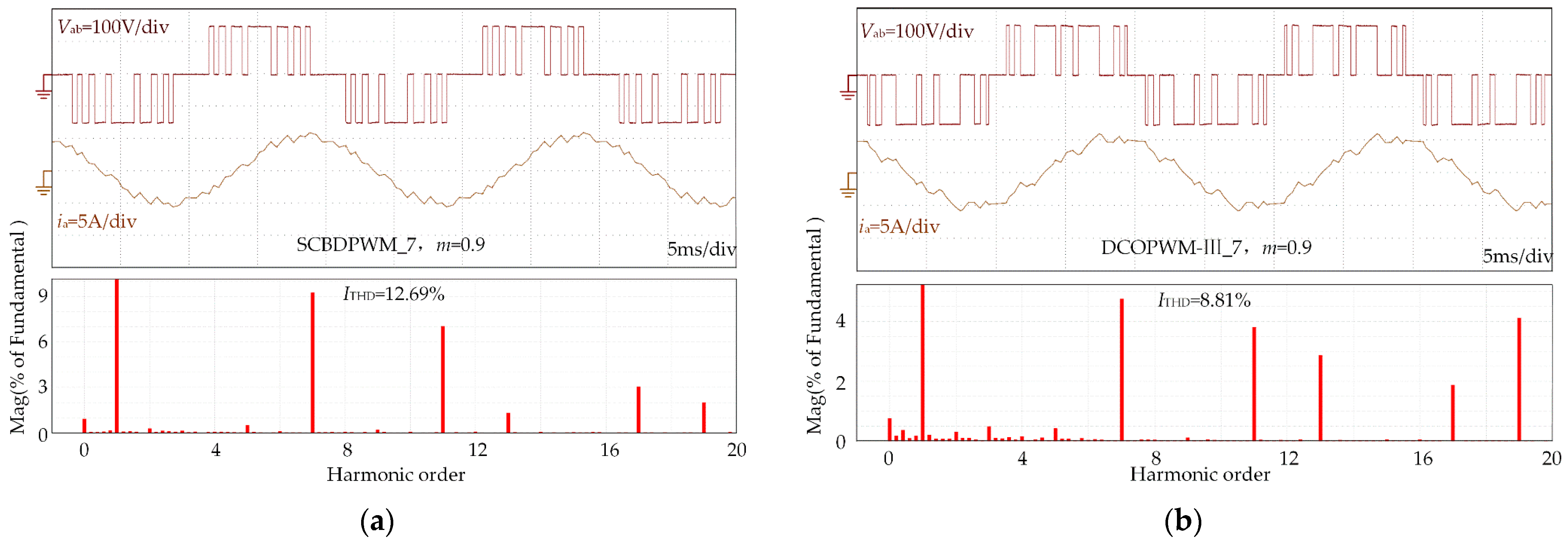

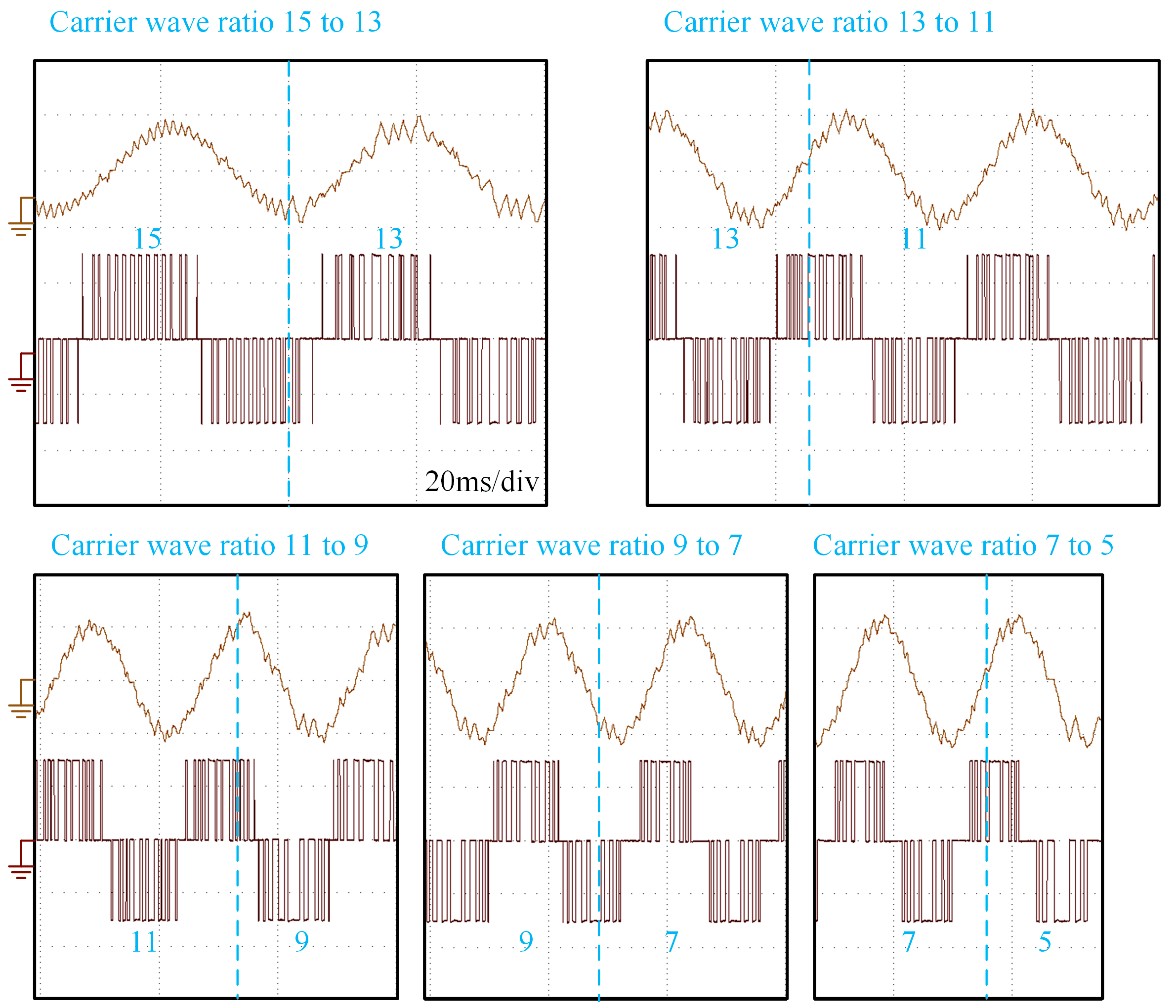
| θ | θ ± 2π | θ + 2/3π | θ ± π | π − θ |
|---|---|---|---|---|
| V0(000) | V0(000) | V0(000) | V7(111) | V0(000) |
| V7(111) | V7(111) | V7(111) | V0(000) | V7(111) |
| V1(100) | V1(100) | V3(010) | V4(011) | V1(100) |
| V2(110) | V2(110) | V4(011) | V5(001) | V2(110) |
| Carrier Wave Ratio | Optimization Strategy | N | Clamping Method | π/2 Moment Carrier Position |
|---|---|---|---|---|
| 5 | ODCPWM-I_5-I | N = 1 | 30° | 1 |
| ODCPWM-I_5-II | N = 1 | 60° | −1 | |
| 7 | ODCPWM-I_7 | N = 2 | 30° | −1 |
| Carrier Wave Ratio | Optimization Strategy | θ1, θ2 | N1, N2 | Clamping Method | Π/2 Moment Carrier Position |
|---|---|---|---|---|---|
| 7 | ODCPWM-II_7 | 10°, 20° | N1 = 1, N2 = 1 | 30° | −1 |
| 13 | ODCPWM-II_13-I | 15°, 15° | N1 = 2, N2 = 1 | 30° | 1 |
| ODCPWM-II_13-II | 15°, 15° | N1 = 2, N2 = 1 | 60° | −1 | |
| ODCPWM-II_13-III | 6°, 24° | N1 = 1, N2 = 2 | 30° | 1 | |
| ODCPWM-II_13-IV | 6°, 24° | N1 = 1, N2 = 2 | 60° | −1 |
| Carrier Wave Ratio | Optimization Strategy | θ1, θ2 | N1, N2 | Clamping Method | π/2 Moment Carrier Position |
|---|---|---|---|---|---|
| 7 | ODCPWM-III_7 | 20°, 10° | N1 = 1, N2 = 1 | 30° | −1 |
| 13 | ODCPWM-III_13-I | 24°, 6° | N1 = 2, N2 = 1 | 30° | 1 |
| ODCPWM-III_13-II | 24°, 6° | N1 = 2, N2 = 1 | 60° | −1 | |
| ODCPWM-III_13-III | 15°, 15° | N1 = 1, N2 = 2 | 30° | 1 | |
| ODCPWM-III_13-IV | 15°, 15° | N1 = 1, N2 = 2 | 60° | −1 |
| System Parameters | Symbols | Values |
|---|---|---|
| DC-link voltage | Vdc | 150 V |
| DC-link capacitance | C1 C2 | 780 μF |
| Load resistance | R | 10 Ω |
| Load inductance | L | 20 mH |
| Rated frequency | fe | 50 Hz |
| Carrier Wave Ratios 13 m = 0.9 | Carrier Wave Ratios 7 m = 0.9 | Carrier Wave Ratios 5 m = 0.9 | |||
|---|---|---|---|---|---|
| modulation strategy | ITHD | modulation strategy | ITHD | modulation strategy | ITHD |
| SCBDPWM | 8.01% | SCBDPWM | 12.69% | SCBDPWM | 11.67% |
| ODCPWM-III_13-III | 6.70% | ODCPWM-III_7 | 8.81% | ODCPWM-III_5 | 11.21% |
Disclaimer/Publisher’s Note: The statements, opinions and data contained in all publications are solely those of the individual author(s) and contributor(s) and not of MDPI and/or the editor(s). MDPI and/or the editor(s) disclaim responsibility for any injury to people or property resulting from any ideas, methods, instructions or products referred to in the content. |
© 2023 by the authors. Licensee MDPI, Basel, Switzerland. This article is an open access article distributed under the terms and conditions of the Creative Commons Attribution (CC BY) license (https://creativecommons.org/licenses/by/4.0/).
Share and Cite
Jin, X.; Liu, J.; Chen, W.; Shi, T. Optimized Synchronous Pulse Width Modulation Strategy Based on Discontinuous Carriers. Energies 2023, 16, 2401. https://doi.org/10.3390/en16052401
Jin X, Liu J, Chen W, Shi T. Optimized Synchronous Pulse Width Modulation Strategy Based on Discontinuous Carriers. Energies. 2023; 16(5):2401. https://doi.org/10.3390/en16052401
Chicago/Turabian StyleJin, Xuefeng, Jiahao Liu, Wei Chen, and Tingna Shi. 2023. "Optimized Synchronous Pulse Width Modulation Strategy Based on Discontinuous Carriers" Energies 16, no. 5: 2401. https://doi.org/10.3390/en16052401





